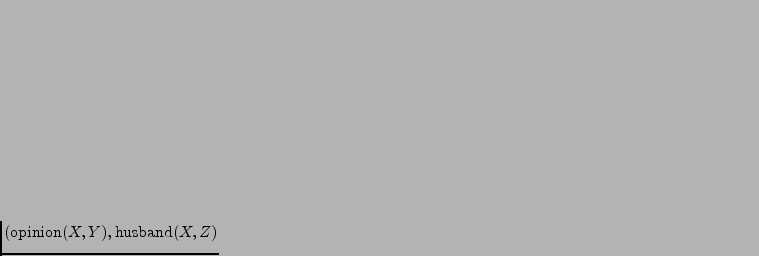



Next: Discussion
Up: Statistical relational learning
Previous: Applications
Contents
Nonlinear relational Markov networks
Bayesian networks assume acyclicity of the network structure. The
directed edges in the graph can be interpreted as causal dependencies
and nothing can cause itself. The same assumption is inherited by BLPs
and PRMs.6.1 In some cases it is difficult or
irrelevant to try to model the direction of the dependency. Say,
whether the husband adopts opinions from his wife, or vice versa, or
whether people with certain combinations of opinions are more likely
to marry. Using directed edges for describing friendship would
definitely lead into cycles with a group of friends. Markov networks
(see Section 3.1.2) model dependencies with
undirected edges so that it only tells that there is a dependency but
not what causes what.
Relational Markov networks (RMN) by Taskar et al. (2002) are to Markov
networks what BLPs are to Bayes networks. A RMN is specified by a set
of clique templates (the logical part) and a potential for each clique
template (the probabilistic part). For instance, the probabilistic
part of the template
 ,
,
 could
describe how the opinions of the husband
could
describe how the opinions of the husband  and wife
and wife  about
the wine
about
the wine  are related. Given a relational database, the
RMN produces an unrolled Markov network over all the attributes in the
data. The cliques instantiated by a certain template share the same clique
potential. Note that an RMN does not require explicit combination
rules.
are related. Given a relational database, the
RMN produces an unrolled Markov network over all the attributes in the
data. The cliques instantiated by a certain template share the same clique
potential. Note that an RMN does not require explicit combination
rules.
The general inference task in RMNs is to compute the posterior distribution over
all the attributes. The network induced by data can be very large
and densely connected, so exact inference is often
intractable. The loopy belief propagation algorithm by Murphy et al. (1999)
(see Section 3.1.1)
is used as an approximation.
The learning task, or the estimation of the clique potentials,
requires alternating between updating the
parameters of the potentials and running the inference algorithm on
the unrolled Markov network.
Nonlinear relational Markov networks (NRMN), introduced in
Publication VI, combine the ideas of relational Markov
networks by Taskar et al. (2002) and nonlinear Markov networks (NMN) by
Hofmann and Tresp (1998) (see Section 3.1.2).
The combination is not very straightforward because the models are quite different:
RMN specifies potentials over cliques of the network whereas NMN
specifies a distribution of each variable given its neighbours in the
network. In NRMN, the first approach is chosen.
Recall Figure 3.1 that shows a Markov network and its join
tree. A node in the join tree corresponds to a clique in a
Markov network. NRMN defines a probability distribution over the
attributes in each clique template. The distributions are provided by HNFA
described in Section 4.4.2.
The maximum entropy combination rule requires marginalisation of
probability distributions. In nonlinear models, this cannot usually
be done exactly and therefore another combination rule was selected. In
the product-of-experts (PoE) combination rule, the probability density
is the average of the incoming probability densities on the
logarithmic scale. A characteristic of PoE is that implicit weighting
happens in some sense automatically. When one of the experts gives a
distribution with high entropy (little information) and another one
with low entropy (much information), the combination is close to the
latter one.
NRMNs extend graphical models in both nonlinear and relational directions at the same time.
Convergence is guaranteed regardless of loops, unlike in the loopy BP algorithm.
There is a lot of room for improvement, though.
The current version of NRMN includes many simplifying assumptions,
such as diagonality of the posterior covariance matrix in HNFA, and
separate learning of experts. Experiments with the game
of Go (see Figure 6.5) give promise for NRMNs.
Figure 6.5:
Top left: The board of a Go game
in progress. Two players alternately place stones on empty points
trying to surround area and opponent stones. Top right: The
expected owner of each point is visualised with the shade of grey.
For instance, the two white stones in the upper right corner are very
likely to be captured. Bottom left: The strings of stones with
their expected owner as the colour of the square. Pairs of related
strings are connected with a blue line if the blocks have same colours
and with a red line when the blocks have opposing colours. The lines
also represent the structure of the implied Markov network. Bottom right: The covariance between owning a point and scoring high
can be used to determine which parts of the board are important (red). The
study of this kind of data is left as future work.
|
|




Next: Discussion
Up: Statistical relational learning
Previous: Applications
Contents
Tapani Raiko
2006-11-21
 ,
,
 could
describe how the opinions of the husband
could
describe how the opinions of the husband  and wife
and wife  about
the wine
about
the wine  are related. Given a relational database, the
RMN produces an unrolled Markov network over all the attributes in the
data. The cliques instantiated by a certain template share the same clique
potential. Note that an RMN does not require explicit combination
rules.
are related. Given a relational database, the
RMN produces an unrolled Markov network over all the attributes in the
data. The cliques instantiated by a certain template share the same clique
potential. Note that an RMN does not require explicit combination
rules.
![\includegraphics[width=0.45\textwidth]{go_13_board.eps}](img354.png)
![\includegraphics[width=0.45\textwidth, trim=0mm 0mm 0mm 0mm, clip]{go_masters.eps}](img355.png)
![\includegraphics[width=0.45\textwidth, trim=0mm 0mm 0mm 0mm, clip]{go_13_pairs_colour.eps}](img356.png)
![\includegraphics[width=0.45\textwidth, trim=32mm 10mm 26mm 1mm, clip]{go_importance.eps}](img357.png)